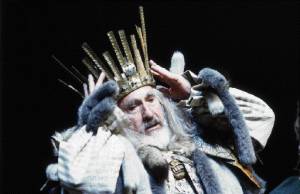













Ayes and Noh have it
The King is the centre of attention. Not only because he is the King. No: he is a star performer, confident and vain, who knows that all eyes are on him. He thinks, however, that this is his own achievement; and the story of Yukio Ninagawa's production of King Lear (Barbican) is the gradual shattering of this conviction.
Nigel Hawthorne's Lear is a warrior: a bluff leader of soldiers and hunters. He strides on vigorously and sits on his throne, where his posture is both monolithic and jaunty. The announcement of the division of the country is not unexpected, but its conditions take the court by surprise. It is the kind of surprise, though, that is almost habitual: there he goes again, the brief exchange of glances between daughters and dukes seems to say, he's thought up something new.
Hawthorne lets you know at once that Lear does not care for advice or contradiction. You can tell, even before anything happens, that any obstacle will provoke him to anger. Lear cannot think two steps ahead. He also likes his own arch jokes and expects genuine, not forced laughter. Lear's history, in this production, is of a man who holds power he does not understand - which is why he cannot understand the consequences of giving it up. Observe Hawthorne at Regan's castle: standing between his two resolute daughters, he senses his power slipping away fast, but he keeps turning from one daughter to the other, protesting, trying to regain the initiative, beginning to panic. The body language is almost that of a supplicant.
This is a hauntingly but savagely beautiful production. Yukio Horio's set is dominated by a huge black wooden walkway sloping gently towards you and widening into an immense platform. At the back the walkway seems to disappear into a black darkness, whence the actors emerge like mythological figures, both real and remote. All this suggests the structure of the classical Noh stage, where the curtained entrance also leads somewhere indeterminate: a primeval darkness that holds no moral secrets. In Ninagawa's production, this reinforces the uncomfortable Shakespearian vision of a world where you are left without the consolation or guidance of a moral order.
The great achievement of director and designer is to have created a world that is both 15th-century Japanese and pre-Christian English. The costumes have the gorgeous richness of the Noh drama; the soldiers could be both Japanese and English. The black walls and the immense wooden gates, which can admit you into a castle, enclose you in a torture chamber or expel you into a comfortless eternity, are painted and embossed with images of flowers and trees: a reminder of Lear's (and Gloucester's and Edgar's) expulsion into a cruel natural world, but also of the importance of such images in Noh plays (and, for that matter, of the vast landscapes in Kurosawa's Lear film, Ran). The Fool (Hiroyuki Sanada) is a kabuki entertainer, athletic and dangerous. Lear and his men have something of the stiff, menacing stride of samurai warriors. This is not just the Japanese heritage industry in action: Ninagawa is presenting a world of monstrous semiology, where power is perceived through its visible signs. Take away these signs and power vanishes.
Sanada is the only Japanese in the cast, speaking a strongly accented but almost always clear and nicely pointed English: a cool fool, serious and disillusioned, who loves Lear with all the love of an outsider craving protection. John Carlisle's Gloucester is a figure of immense dignity and power: a great lord whose moral stature, combined with short-sightedness and irascibility, rather like Lear's, makes his destruction equally tragic. When the two old men, one blind, one mad, sit on the ground and embrace, it is like some ancient, life-size netsuke: two figures huddling together almost like one, sharing the same hell.
Sian Thomas is a lithe, sexy, viper-like Goneril: a coldly poisonous but carefully balanced performance. Her erotic teasing of Nicolas Tennant's sly, sleazy Oswald is horribly fascinating. Anna Chancellor, in her Shakespearian debut, catches perfectly the well-bred sadism in Regan, but her verse-speaking needs more rhythm and colour. Michael Malo-ney's Edgar is another star performance: a thoughtful innocent who becomes a fighter and the bearer of that moral redemption that everybody in the play so badly needs.
The end is profoundly moving, precisely because it is so simple, muted and dignified. Lear does not whinge or prattle in his mad scenes: he is in a world of a private, visionary sanity, where things look newborn and translucent. His condition is all the more touching because he is still physically fit: when you hear that he killed Cordelia's murderer, you believe it.
The great Greek scholar E R Dodds has
written about the way ancient Greek
civilisation passed from a shame culture to a
guilt culture. Something similar happens to
Hawthorne's Lear. This magnificently gnarled
performance shows how the King passes from
shame, the public stigma of losing power, to a
sense of guilt, which is a man's moral
judgment over himself. Edmund (William
Armstrong) says: "Men are as the time is" - the
apology of all offenders. Lear learns the
opposite: that you make your own world.
Perhaps both are true, which explains the
fallibility of all moral systems. That
recognition is at the core of this play,
Ninagawa's huge production, and the searing
dignity of Hawthorne's performance.
